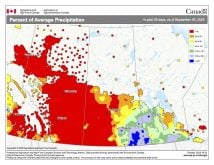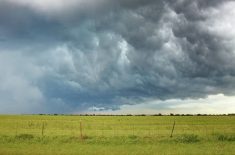Spring has been warmer than usual this year, making rain even more important.
In the semi-arid Prairies, soils that hold some of winter’s meltwater may give emerging crops a good start but the finish is up to the water delivered by seasonal rainfall. Crop physiology depends on it.
“Water is the key ingredient when it comes to photosynthesis,” says Paul Bullock, a retired soil scientist from the University of Manitoba. “You need carbon dioxide in the atmosphere along with soil water and when you get those two together, the plants can make organic molecules. It’s at the base of the food chain.”
Read Also

Moo translator and methane measures: There’s an app for that
Dalhousie University researchers use artificial intelligence to create new dairy farm apps that analyze cattle sounds and measure methane.
The bluestems and spear grasses that first colonized the Great Plains are masters at holding and conserving water. Their tillers gather rain so it trickles to the centre of the plant, where it percolates through the soil into the deep root zone.
Some domestic species, like wheat, rye and flax, come from semi-arid regions themselves, but they still need supplemental rainfall. With one season to live, they pour everything they have into making seed and produce as little stem, leaves and roots as possible.
The seeds are their one shot at starting the next generation, so making seed is all important.
These annuals don’t develop deep roots so they can’t reach moisture deeper down.
Since the business of being a plant involves gathering soil moisture and moving it into the atmosphere, the plants pump water out of the root zones. They dry out the soil so a few good top ups are required to keep the factory in production.
“The fastest way to dry out the root zone of the soil is to put a plant in it, make it happy, make it healthy,” Bullock said. “Give it a good root and it will pump that soil dry way faster than if you leave it bare and expect it to evaporate dry.”
Although this sounds self-destructive, the plant uses water for two processes. The first is photosynthesis, using sunlight to break water and carbon dioxide into their component parts. Then they recombine the atoms into sugars and amino acids, using soil nutrients their roots bring in, to make tissue.
“Plants have adapted to utilize solar energy both as an energy source but also to drive this whole photosynthetic process so that you can create these organic molecules,” Bullock said. “So it’s very, very fundamental.”
The other process is evapotranspiration, the plant’s evaporation-driven circulatory system. The plants get carbon dioxide through the stomata. Some water vapour escapes into the atmosphere from the plant’s vascular system. As water molecules leave, they pull the next ones closer to the stomata.
“It’s a pipeline, and a nutrient transfer system as well, pumping up through the stems and the leaves to supply the tissues in the plant with the nutrients that are required,” Bullock said. “There’s a tremendous amount of water taken up by the plants that ends up right back in the atmosphere as water vapour. In fact, in dryland farming, the majority of that water is just cycled right back to the atmosphere.”
But it starts in the root zone where the plant’s specialized root tissue collects it and feeds it into the main body. Once the plant has pulled water from the soil, it depends heavily on rainfall to replenish it. How well the soil can receive and hold water depends on its type.
“The main thing is the texture, the particle size and the particle size distribution,” Bullock said. “So it’s the size of the particles themselves, whether they’re sands, silts or clays and the mixes of them that impacts the amount of soil water storage that you get.”
Three basic particle types make up the mineral portion of soil: sand, the largest, silt, the intermediate, and clay, the smallest. The smaller the particle size, the better the soil is at holding water.
Rain on sandy soils tends to trickle down the profile and drain quickly. The other extremes are clay soils.
“They are exceedingly level, not a lot of topography on them, hardly any stones,” Bullock said. “When they get wet, it takes a while for them to drain. They can shrink and swell so they’re kind of dynamic.”
At the intermediate position are loamy soils, the combination of sand, silt and clay that is most common throughout the Prairies.
There are also complex combinations like a sandy soil sitting atop a heavy clay layer.
“Their nickname is ‘the wet sands’ because rain in sandy soil infiltrates quickly and is lost below the root zone very quickly.” Bullock said. “But water that might be lost in the root zone doesn’t go very far. It sits on a perched water table over top of the clays.”
A lateral water flow may result along that clay layer as it follows gravity to a lower point. It acts like an aquifer and may even provide groundwater to other fields. This is an exception to the replenishing rainfall rule.
“That’s another source of water that can be very, very important especially … where you had a very, very wet year followed by a dry year,” Bullock said. “You can actually capture some of that water as groundwater from the year before where it provided another source for the plants to tap into.”
Crop farming sits at the intersection of complex systems, in this case plants, soils and weather. The quality of the harvest depends on rainfall, how the soils hold it and how the plants can use it.
“If you had your clay soils filled to their maximum water holding capacity and then it doesn’t rain on them for the rest of the crop season, you’re going to have a crop failure,” Bullock said. “Your crops are not going to be good at all. They will run out of water at some point.”















